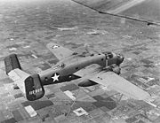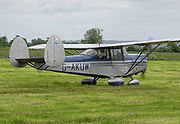
Twin tail
Encyclopedia

Vertical stabilizer
The vertical stabilizers, vertical stabilisers, or fins, of aircraft, missiles or bombs are typically found on the aft end of the fuselage or body, and are intended to reduce aerodynamic side slip. It is analogical to a skeg on boats and ships.On aircraft, vertical stabilizers generally point upwards...
arrangement found on the empennage
Empennage
The empennage , also known as the tail or tail assembly, of most aircraft gives stability to the aircraft, in a similar way to the feathers on an arrow...
of some aircraft
Aircraft
An aircraft is a vehicle that is able to fly by gaining support from the air, or, in general, the atmosphere of a planet. An aircraft counters the force of gravity by using either static lift or by using the dynamic lift of an airfoil, or in a few cases the downward thrust from jet engines.Although...
. Two vertical stabilizers — often smaller on their own than a single conventional tail would be — are mounted at the outside of the aircraft's horizontal stabilizer. This arrangement is also known as an H-tail, as it resembles a capital "H" when viewed from rear.
A special case of twin tail is twin boom tail or double tail where the aft airframe consists of two separate fuselages, "tail booms", which each have one fin and rudder but share a conjoined one single horizontal stabilizer. Examples of this construction are Lockheed P-38 Lightning
P-38 Lightning
The Lockheed P-38 Lightning was a World War II American fighter aircraft built by Lockheed. Developed to a United States Army Air Corps requirement, the P-38 had distinctive twin booms and a single, central nacelle containing the cockpit and armament...
, Northrop P-61 Black Widow
P-61 Black Widow
The Northrop P-61 Black Widow was the first operational U.S. military aircraft designed specifically for night interception of aircraft, and was the first aircraft specifically designed to use radar. It was an all-metal, twin-engine, twin-boom design developed during World War II...
, Focke-Wulf Fw 189
Focke-Wulf Fw 189
|-See also:-References:NotesBibliography* Brown, Capt. Eric . Wings of the Luftwaffe. Garden City, NY: Doubleday & Company, Inc., 1978. ISBN 0-385-13521-1....
, De Havilland Vampire
De Havilland Vampire
The de Havilland DH.100 Vampire was a British jet-engine fighter commissioned by the Royal Air Force during the Second World War. Following the Gloster Meteor, it was the second jet fighter to enter service with the RAF. Although it arrived too late to see combat during the war, the Vampire served...
and C-119 Boxcar
Design
Separating the control surfaces allows for additional rudder area or vertical surface without requiring a massive single tail. On multi-engine propellerPropeller (aircraft)
Aircraft propellers or airscrews convert rotary motion from piston engines or turboprops to provide propulsive force. They may be fixed or variable pitch. Early aircraft propellers were carved by hand from solid or laminated wood with later propellers being constructed from metal...
designs twin fin and rudders operating in the propeller slipstream give greater rudder authority and improved control at low airspeed
Airspeed
Airspeed is the speed of an aircraft relative to the air. Among the common conventions for qualifying airspeed are: indicated airspeed , calibrated airspeed , true airspeed , equivalent airspeed and density airspeed....
s, and when taxiing
Taxiing
Taxiing refers to the movement of an aircraft on the ground, under its own power, in contrast to towing or push-back where the aircraft is moved by a tug...
. A twin tail can also simplify hangar
Hangar
A hangar is a closed structure to hold aircraft or spacecraft in protective storage. Most hangars are built of metal, but other materials such as wood and concrete are also sometimes used...
requirements, give dorsal gunners enhanced firing area, and in some cases reduce the aircraft's weight. It also affords a degree of redundancy
Redundancy (engineering)
In engineering, redundancy is the duplication of critical components or functions of a system with the intention of increasing reliability of the system, usually in the case of a backup or fail-safe....
- if one tail is damaged, the other may remain functional.
Most often, the twin vertical surfaces are attached to the ends of the horizontal stabliizer, but a few aircraft in aviation history - like the Armstrong Whitworth Whitley
Armstrong Whitworth Whitley
The Armstrong Whitworth A.W.38 Whitley was one of three British twin-engine, front line medium bomber types in service with the Royal Air Force at the outbreak of the Second World War...
, Mitsubishi G3M
Mitsubishi G3M
The Mitsubishi G3M was a Japanese bomber used during World War II.-Design and development:...
and Dornier Do 19, had their twin vertical surfaces mounted to the upper surface of the fixed stabilizer instead, at some distance inwards from the horizontal stabilizer's tips.
Many canard
Canard (aeronautics)
In aeronautics, canard is an airframe configuration of fixed-wing aircraft in which the forward surface is smaller than the rearward, the former being known as the "canard", while the latter is the main wing...
aircraft designs incorporate twin tails on the tips of the main wing
Wing
A wing is an appendage with a surface that produces lift for flight or propulsion through the atmosphere, or through another gaseous or liquid fluid...
. Very occasionally, three or more tails are used, as on the Breguet Deux-Ponts
Breguet Deux-Ponts
The Breguet 761/763/765 were a family of 1940s and 1950s French double-deck transport aircraft produced by Breguet. The aircraft were normally called the Deux-Ponts but it was not an official name.-Design and development:...
, Lockheed Constellation
Lockheed Constellation
The Lockheed Constellation was a propeller-driven airliner powered by four 18-cylinder radial Wright R-3350 engines. It was built by Lockheed between 1943 and 1958 at its Burbank, California, USA, facility. A total of 856 aircraft were produced in numerous models, all distinguished by a...
and Boeing 314 Clipper. A very unusual design can be seen on the E-2 Hawkeye
E-2 Hawkeye
The Grumman E-2 Hawkeye is an American all-weather, aircraft carrier-capable tactical airborne early warning aircraft. This twin-turboprop aircraft was designed and developed during the late 1950s and early 1960s by the Grumman Aircraft Company for the United States Navy as a replacement for the...
, which has two additional vertical tails fixed to the horizontal stabilizer between the normal vertical twin-tail surfaces. This arrangement was chosen for the stringent size limitations of carrier-based aircraft.

B-24 Liberator
The Consolidated B-24 Liberator was an American heavy bomber, designed by Consolidated Aircraft of San Diego, California. It was known within the company as the Model 32, and a small number of early models were sold under the name LB-30, for Land Bomber...
, Handley-Page Halifax Avro Lancaster
Avro Lancaster
The Avro Lancaster is a British four-engined Second World War heavy bomber made initially by Avro for the Royal Air Force . It first saw active service in 1942, and together with the Handley Page Halifax it was one of the main heavy bombers of the RAF, the RCAF, and squadrons from other...
, and P-38 Lightning
P-38 Lightning
The Lockheed P-38 Lightning was a World War II American fighter aircraft built by Lockheed. Developed to a United States Army Air Corps requirement, the P-38 had distinctive twin booms and a single, central nacelle containing the cockpit and armament...
. The arrangement is not limited to World War II
World War II
World War II, or the Second World War , was a global conflict lasting from 1939 to 1945, involving most of the world's nations—including all of the great powers—eventually forming two opposing military alliances: the Allies and the Axis...
-vintage aircraft, however. Many fighter aircraft
Fighter aircraft
A fighter aircraft is a military aircraft designed primarily for air-to-air combat with other aircraft, as opposed to a bomber, which is designed primarily to attack ground targets...
, like the F-14 Tomcat
F-14 Tomcat
The Grumman F-14 Tomcat is a supersonic, twin-engine, two-seat, variable-sweep wing fighter aircraft. The Tomcat was developed for the United States Navy's Naval Fighter Experimental program following the collapse of the F-111B project...
, F-15 Eagle
F-15 Eagle
The McDonnell Douglas F-15 Eagle is a twin-engine, all-weather tactical fighter designed by McDonnell Douglas to gain and maintain air superiority in aerial combat. It is considered among the most successful modern fighters with over 100 aerial combat victories with no losses in dogfights...
, Sukhoi Su-27
Sukhoi Su-27
The Sukhoi Su-27 is a twin-engine supermanoeuverable fighter aircraft designed by Sukhoi. It was intended as a direct competitor for the large United States fourth generation fighters, with range, heavy armament, sophisticated avionics and high manoeuvrability...
, Mig-29, and A-10 Thunderbolt II
A-10 Thunderbolt II
The Fairchild Republic A-10 Thunderbolt II is an American single-seat, twin-engine, straight-wing jet aircraft developed by Fairchild-Republic in the early 1970s. The A-10 was designed for a United States Air Force requirement to provide close air support for ground forces by attacking tanks,...
, make use of twin tail configurations, as do civilian and cargo designs like the Antonov An-14
Antonov An-14
|-See also:- References :* Stroud, John. Soviet Transport Aircraft since 1945. London:Putnam, 1968. ISBN 0-370-00126-5.-External links:* *...
, Antonov An-22
Antonov An-22
The Antonov An-22 Antei was the world's heaviest aircraft, until the advent of the American C-5 Galaxy and later the Soviet An-124. Powered by four pairs of contra-rotating turboprops, the design remains the world's largest turboprop-powered aircraft...
, Antonov An-28
Antonov An-28
|-See also:-External links:**...
, Antonov An-38
Antonov An-38
|-See also:...
, Antonov An-225
Antonov An-225
The Antonov An-225 Mriya is a strategic airlift cargo aircraft, designed by the Antonov Design Bureau in the 1980s. It is the world's heaviest aircraft. The design, built in order to transport the Buran orbiter, was an enlargement of the successful An-124 Ruslan...
, Beechcraft 18, Beriev Be-12
Beriev Be-12
|-See also:-Bibliography:* Yefim Gordon, Andrey Sal'nikov and Aleksandr Zablotskiy Beriev's Jet Flying Boats. Hinckley, UK: Midland Publishing. ISBN 1-85780-236-5...
, ERCO Ercoupe, Burt Rutan
Burt Rutan
Elbert Leander "Burt" Rutan is an American aerospace engineer noted for his originality in designing light, strong, unusual-looking, energy-efficient aircraft...
’s Long-EZ
Rutan Long-EZ
-See also:-External links:****...
and SpaceShipOne also Shorts 330
Shorts 330
|-See also:-Bibliography:* Barnes C.H. and James Derek N. Shorts Aircraft since 1900. London: Putnam, 1989. ISBN 0-85177-819-4.* Donald, David, ed. The Encyclopedia of Civil Aircraft. London: Aurum, 1999. ISBN 1-85410-642-2....
.
Future Aircraft
Airbus has filed a patent for a new, twin-tail, trijetTrijet
A Trijet is an aircraft powered by three jet engines. Early twin-jet designs were limited by the FAA's "60-minute rule", whereby the flight path of twin-engined jetliners was restricted to within 60 minutes' flying time from a suitable airport, in case of engine failure. In 1964 this rule was...
design, but it is unknown if this will ever come to market.

